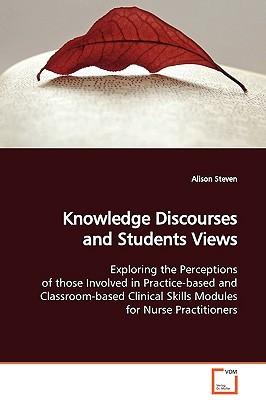
- We will send in 10–14 business days.
- Author: Alison Steven
- Publisher: VDM Verlag
- ISBN-10: 3639130065
- ISBN-13: 9783639130065
- Format: 15.2 x 22.9 x 2 cm, softcover
- Language: English
- SAVE -10% with code: EXTRA
Reviews
Description
Over the years trends in clinical skills education have swung between classroom based simulation and clinical based experience. Furthermore with the development of new roles such as the Advanced Nurse Practitioner, certain clinical skills are no longer the domain of one profession. However little research has investigated the perceptions of those involved in different educational strategies or the factors which influence their views. This book explores the perceptions of those involved in two types of clinical skills education for the role of nurse practitioner. The history of clinical skills education is traced and an analysis of the perceptions expressed over the course of an educational initiative undertaken. Perceptions are clearly linked to wider knowledge discourses and a model of discourse positioning and movement developed. The study raises issues for research, education and practice, and informs contemporary debates regarding educational evaluation and the theory-practice gap. The book should be useful to a range of health care professionals, educationalists, researchers and those interested in knowledge translation.
EXTRA 10 % discount with code: EXTRA
The promotion ends in 17d.06:30:47
The discount code is valid when purchasing from 10 €. Discounts do not stack.
- Author: Alison Steven
- Publisher: VDM Verlag
- ISBN-10: 3639130065
- ISBN-13: 9783639130065
- Format: 15.2 x 22.9 x 2 cm, softcover
- Language: English English
Over the years trends in clinical skills education have swung between classroom based simulation and clinical based experience. Furthermore with the development of new roles such as the Advanced Nurse Practitioner, certain clinical skills are no longer the domain of one profession. However little research has investigated the perceptions of those involved in different educational strategies or the factors which influence their views. This book explores the perceptions of those involved in two types of clinical skills education for the role of nurse practitioner. The history of clinical skills education is traced and an analysis of the perceptions expressed over the course of an educational initiative undertaken. Perceptions are clearly linked to wider knowledge discourses and a model of discourse positioning and movement developed. The study raises issues for research, education and practice, and informs contemporary debates regarding educational evaluation and the theory-practice gap. The book should be useful to a range of health care professionals, educationalists, researchers and those interested in knowledge translation.


Reviews